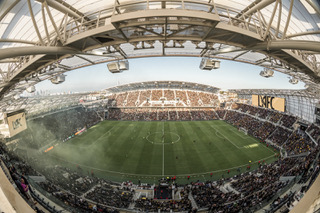Ruckus partners with stadium for ultra-dense Wi-Fi
Los Angeles Football Club (LAFC) has chosen Ruckus Networks to deliver its indoor and outdoor Wi-Fi access points (APs) to bring a state-of-the-art and “frictionless” fan experience to guests at the Banc of California Stadium.
?We wanted a seamless wireless technology that would set our venue apart from other stadiums,? said Christian Lau, vice president of Information Technology for LAFC, said in an interview with In-Building Tech.
“In terms of connectivity performance, it was not an easy stadium to design given the density of the venue and the number of required access points, but Ruckus Networks provided the AP solutions we needed to deliver a superior fan experience. Knowing that our customers range from 24 to 36 years in age, for whom connectivity is top of mind, we wanted to ensure that we could deliver the best,? said Lau.
The LAFC Wi-Fi implementation consists of 489 Ruckus APs, including the R710 indoor AP, designed for ultra-dense device environments like the inside enclosure of the stadium. In the bowl of the stadium, 314 APs, of which 38 are the Ruckus E510 outdoor AP with its low-profile external BeamFlex+TM antennas, were also installed in the end zone standing areas.
“In high-density network environments like stadiums it can be difficult to deliver a consistent Wi-Fi experience, which is now becoming critical to fan attendance,” said Bart Giordano, senior vice president of Worldwide Sales, Ruckus Networks.
Among LAFC?s top requirements was finding a Wi-Fi solution that could not only meet the stadium?s increased density needs but also support back-of-the-house networks, ticketing at the gates, and point-of-sale applications.
The Wi-Fi network had to be the most robust possible to support the LAFC?s mobile app and artificial intelligence-based chatbot used for guest services for express pickup and in-seat delivery, which heavily rely on network connectivity.
These technology enhancements will help stadium owners to maximize both guest experience and revenue by enabling customers who may have forgone visits to purchase food, beverage and merchandise in the interest of missing action-packed matches.
Wi-Fi connectivity at the endpoint was also a critical deliverable for LAFC which is currently piloting near field communication (NFC) for contactless ticketing passes that will soon be rolled out stadium-wide.
The newly built venue, which will hold a variety of events ranging from soccer matches, boxing tournaments, rugby, concerts and music festivals, corporate meetings and e-sports, was designed to solve pain points for customers such as ease of entry and exiting at gates, long concession lines and in-seat experience.
While the seating capacity of the stadium is 22,000, the wireless network is intentionally engineered for 70,000 users because LACS wanted to ensure the Wi-Fi scalability and future-proof the stadium for biometric and augmented reality applications, which the club is currently developing and testing.
?For us, future-proofing for applications like biometrics and augmented reality, which can improve the guest experience and drive revenue in the future was top-of-mind. Biometric ticketing gets people in the seat much faster and ties guests to our membership platform, while bio age verification reduces the transaction times and lines at concessions from 30 to 40 seconds down to two seconds,? Lau said.

